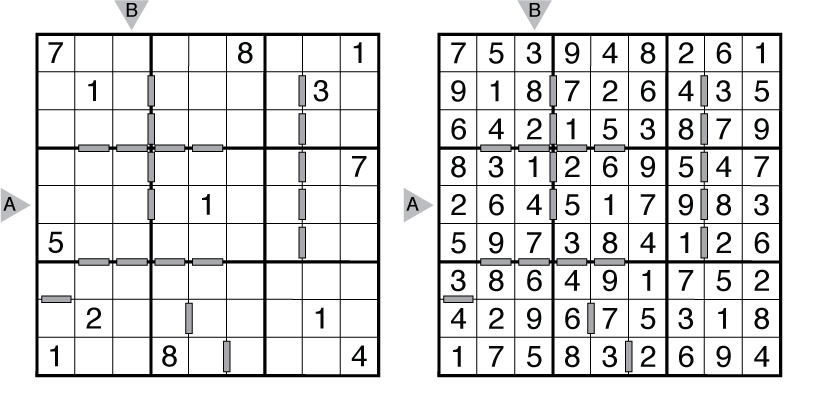Consecutive Sudoku R&I

Rules: Standard Sudoku rules (insert a number in the indicated range into each cell so that no number repeats in any row, column, or bold region). Some bars are in the grid; any two adjacent numbers separated by a bar must be consecutive (i.e., differ by 1). All adjacent numbers not separated by a bar cannot be consecutive.
Answer String: Enter the row/column marked “A”, followed by a comma, followed by the row/column marked “B”. Rows are entered from left to right and columns from top to bottom. This example has the key “264517983,382147695”.
(Brief) History of Consecutive Sudoku: Descended from Sudoku puzzles and other variations. Consecutive Sudoku is a Japanese nanpure variation, likely created before the return of “Sudoku” to the West. (If you know more about the original author/publication of this style, please tell us).
History of this example: This “+/- 1” Consecutive Sudoku was written by Thomas Snyder for Sudoku Cup 3.
Sources for Consecutive Sudoku: Follow this link for Consecutive Sudoku puzzles on this website. If you are new to this puzzle type, here are our easiest Consecutive Sudoku to get started on. More Consecutive Sudoku puzzles can be found in Mutant Sudoku, and also in future titles by Grandmaster Puzzles.
Design rules for contributors: A Grandmaster Consecutive Sudoku will have a unique solution that can be reached by logic alone. Generally, a Grandmaster Consecutive Sudoku has a symmetric layout of numbers and a visually interesting layout of bars. The “all or nothing” nature of the consecutive rule often introduces unintended bars to the visual theme which is acceptable. Given numbers should only rarely appear in cells with marked bars.
